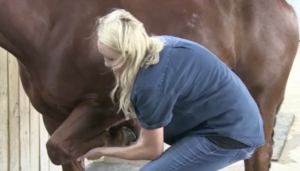
Veltri assessing a horse’s range of motion.
Stretching before a big show or a hard training session is very important to keep muscles flexible, strong and healthy. Many horse owners already stretch their horse’s neck side to side with treats before a ride, but did you know there are more stretches you can do to keep your equine athlete performing at his best?
Equine Massage Therapist, Tiffanie Veltri likes to educate her clients on how to thoroughly stretch their own horses. These techniques help owners maintain their horse’s flexibility and make sure the key muscle groups are getting released.
First off, be aware of how your horse handles being touched and stretched, especially a young horse. For example, a horse that has seen the farrier regularly will be comfortable with it’s hooves and legs being handled.
“Make sure you know your horse and know how they’re going to react…Be aware of where their mindset is at,” Veltri said.
Make sure that your horse is standing square during each of these stretches. Be very careful and consider any injuries your horse may have. Don’t be afraid to get professional help and/or instruction before doing these stretches on your own.
“Every time you’re exercising and training, before and after you do any kind of performance, it’s a great routine to get into to do these stretch motions,” Veltri said.
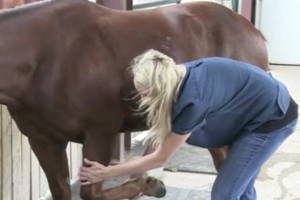
Veltri performing a
shoulder stretch.
Front Leg
Veltri starts off gently bending the horse’s knee, making sure everything lines up properly. If it does not line up correctly, it could indicate that a muscle is pulling the structure incorrectly. This might indicate the need for a chiropractor or massage therapist.
She suggests moving the fetlock around to check the range of motion, and while holding the hoof, she said, give the shoulder a slight shake to help loosen the horse through the withers and pectoral muscles.
“The shoulder doesn’t have a huge range of motion when you’re asking it to come backwards.”
If you gently pull the hoof backwards while keeping the leg at a 90 degree angle, it will open the shoulder joint. Make sure you keep inline with the body, don’t pull the leg to the outside or inside.
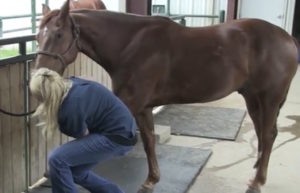
Veltri demonstrating a safe position to stretch a horse.
“There are stretches you can do [inside and outside the normal range of motion] but you have to know how far that horse can easily do that without causing any [extra] stress,” said Veltri.
You can bring the leg forward like a farrier would and stretch them focusing on the triceps, shoulders, and elbow muscles. Face forward as opposed to facing the horse. Hold the position for about 10-15 seconds.
“You’re in a compromised position [if you’re facing the horse]. [Have your back to the horse] if the horse was to get scared and bolt away, you’re in a position to get out of the stretch [and get out of harm’s way].”
“You can increase the range of motion each time you practice the stretch.”
Hind Leg
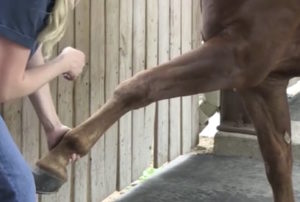
A stretch focusing on triceps, shoulders and muscles around the elbow.
For the hind leg, ask them to bend or flex their hock and see what kind of range of motion they have. Then hold the fetlock and stretch the leg forward under the horse slightly pulling it to stretch forward.
“This is really good for the hip, hamstring muscles and the joints in the lower limb,” Veltri said.
From there, you can go into a back-of-leg stretch. By gently pulling the leg backwards, in line with the body, to stretch the stifle.
“Make sure you’re in a safe position. If they are uncomfortable you want to address that.”
This is a good time to flex and move the pasterns and fetlock to check range of motion as well.
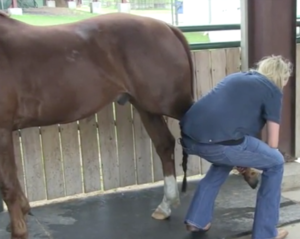
Veltri performing a stifle stretch.
Back and Abdomen
Back and abdominal strength are crucial for equine athletes, Veltri said. You can palpate (use your hands to feel) the rump on either side of the tail and cause the horse to flex his back up. Be careful and make sure your horse is comfortable with you handling him in that way and make sure you are not in kicking range.
“In the middle of the horse’s sternum give [the horse] a tickle [or scratch] and see them raise their back. What this does is engage their abdominal muscles and help strengthen the back muscles.”
Neck
For neck stretches you might need some enticement. Veltri recommends hay because it gives you a little wiggle room
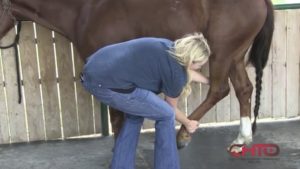
Veltri stretching the hip, hamstring and lower limb joints.
without endangering your fingers as well as giving you a little more leverage.There are a series of neck stretches she likes to use. She will have a horse stretch to the side and have the horse point its nose to its hock and try to have the horse hold that position as long as it can and then go back to neutral or straight.
The second neck stretch is stretching the nose around and pointing it to the stifle.
“One thing [massage therapists] notice, when we’re stretching horses, is how are they stretching?…Anytime they’re having to over work and really stretch, those are areas we would want to address.”
She will watch how the horse moves its head around and see if the horse is twisting its head to reach hay or treat, if he is, it could mean there is some tension in the poll.
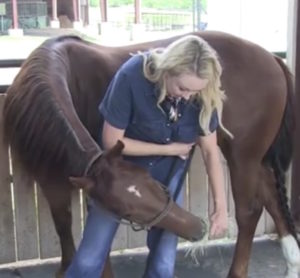
Veltri asking the horse to stretch around her, for hay, pointing its nose at the hock.
“You really want their nose to stretch flat to the [hock and stifle] verses having to strain and twist,” she said.
When doing the neck stretches, you might have to use a wall to help them position themselves where they are supposed to be so they don’t move around to follow the food. It’s also good for them to have to stretch around you.
Another helpful stretch Veltri uses encourages the horse to bring its head down between the lower legs, and then up by the chest. Veltri said this stretch helps release the poll. Have them stand as square as possible and stretch their head and neck forward without them moving forward.
“This helps stretch the neck and poll region and release the back as well.”
Veltri recommends adding time into your program to stretch your horse.
“It will definitely help with reduction of injuries and keeping their range of motion as free as possible.”
Veltri said it’s important to make sure the horse is cleared by the vet if there has been an injury before stretching your horse.
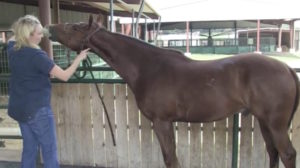
A neck and poll stretch.
Veltri said do not do stretching, chiropractic or massage work on the horse if they are sick, feverish, or on antibiotics. She said it’s great to massage and stretch your horse everyday and the more often you do so, the more you will know your horse’s muscles and alignment and when something needs extra attention or a professional.
